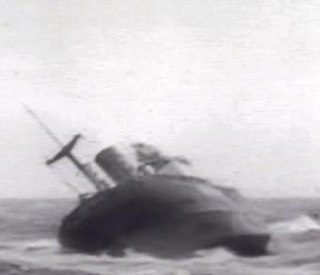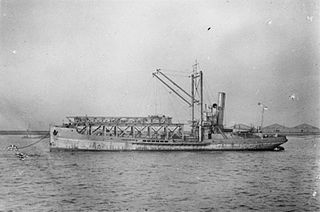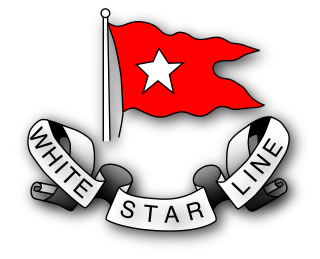
The Victory ship was a class of cargo ship produced in large numbers by North American shipyards during World War II to replace losses caused by German submarines. They were a more modern design compared to the earlier Liberty ship, were slightly larger and had more powerful steam turbine engines giving higher speed to allow participation in high speed convoys and make them more difficult targets for German U-boats. A total of 531 Victory ships were built.

SS Robin is a 350 gross registered ton (GRT) steam coaster, a class of steamship designed for carrying bulk and general cargoes in coastal waters, and the oldest complete example in the world. One of a pair of coasters built in Bow Creek, London] in 1890, the ship was built for British owners, but spent most of her long working life on the Spanish coast as Maria.

SS American Victory is a Victory ship which saw brief service in the Pacific Theater of Operations during the waning months of World War II, Korean War from 1951-1954, and Vietnam War from 1967-1969. Built in June 1945, she carried ammunition and other cargo from U.S. West Coast ports to Southeast Asia, then ferried cargo, equipment and troops back to the U.S. after the war ended. She survived two typhoons, and one hurricane. She sailed around the world twice.
Princess Luisa Maria of Belgium, Archduchess of Austria-Este is the fourth child and second daughter of Lorenz, Archduke of Austria-Este, and Princess Astrid of Belgium. She was born at the Saint Jean Hospital in Brussels, Belgium, and is currently ninth in line to the Belgian throne.

SS Red Oak Victory is a U.S. military Victory ship of the Boulder Victory-class cargo ship used in the Second World War. She was preserved to serve as a museum ship in Richmond, California, and is part of the Rosie the Riveter/World War II Home Front National Historical Park. She was one of 534 Victories built during World War II, but one of only a few of these ships to be transferred from the Merchant Marine to the United States Navy. She was named after Red Oak, Iowa, which suffered a disproportionate number of casualties in early World War II battles.. The ship was active during World War II, the Korean War, and the Vietnam War.
Maria Luisa may refer to:

SS Flying Enterprise was a 6,711 ton Type C1-B ship which sank in 1952. She was built in 1944 as SS Cape Kumukaki for the United States Maritime Commission for use in World War II. The ship was sold in 1947 and then operated in scheduled service under the name Flying Enterprise.

HMS Slinger was an experimental catapult ship operated by the Royal Navy during the First World War. After Royal Navy service from 1917 to 1919, she operated as a commercial cargo ship under the names SS Niki and SS Lingfield from 1920 until she sank in 1941.

SS Minnesotan was a cargo ship built in 1912 for the American-Hawaiian Steamship Company. During World War I she was known as USAT Minnesotan in service for the United States Army and USS Minnesotan (ID-4545) in service for the United States Navy. She ended her career as the SS Maria Luisa R. under Italian ownership. She was built by the Maryland Steel Company as one of eight sister ships for the American-Hawaiian Steamship Company, and was employed in inter-coastal service via the Isthmus of Tehuantepec and the Panama Canal after it opened.
Empire Ballad was a 6,640 ton cargo ship which was built by Bartram & Sons Ltd, Sunderland in 1941 for the Ministry of War Transport (MoWT). She was sold to Alexander Shipping Co Ltd in 1946 and renamed Bibury. In 1951 she was sold to Halcyon Lijn NV, Rotterdam, Netherlands and renamed Stad Maassluis. In 1962 she was sold to Compagnia Navigazione Jaguar, Panama and renamed Jaguar. In 1966 she was sold to Olamar SA, Panama and renamed Goldfield. In 1968 she was sold to Compagnia de Navigazione Sulemar, Panama and renamed Poseidon, serving until 1969 when she ran aground and was subsequently scrapped.

USS Munrio (ID-2054) was a cargo ship that served in the United States Navy from 1918 to 1919.
Empire Baron was a 5,890 GRT cargo ship which was built in 1926 for Navigazione Generale Gerolimich & Compagnia Società in Anzioni, Trieste, Italy. She was captured by the Royal Navy in 1940 and ownership passed to the Ministry of War Transport (MoWT). She was renamed Empire Baron. She was sold in 1947 to Navigation & Coal Trade Ltd, London and renamed Rubystone. She was sold to a Panamanian company in 1951 and was scrapped in 1960.
Ingénieur Général Haarbleicher was a 7,067 GRT cargo ship which was built in 1944 for the Ministry of War Transport (MoWT) as Empire Call. In 1945 she was sold to the French government and renamed Ingénieur Général Haarbleicher. In November 1945, she ran aground on Stromboli and broke in two. Declared a total loss, she was scrapped in 1947.

Santa Kyriaki was a 2,958 GRT cargo ship that was built in 1945 as Empire Crusoe by Ailsa Shipbuilding Co, Troon, Ayrshire, Scotland for the Ministry of War Transport (MoWT). She was sold in 1946 and renamed Greenland and a further sale in 1955 saw her renamed Heminge. In 1956, she was sold to Liberia and renamed Maria Luisa. A sale in 1963 to a Panamanian company saw her renamed Santa Kyriaki. She served until running aground off IJmuiden, Netherlands in 1965 and was scrapped in 1966.

SS Gallic was a cargo steamship built in 1918. During her career, she had six different owners and sailed under the flags of the United Kingdom, Panama and Indonesia. In spite of prevailing maritime superstition that it is unlucky to change a ship's name, she underwent seven name changes and survived a 37-year career unscathed. She was scrapped at Hong Kong in 1956, the last surviving White Star Line cargo ship.

The SS Cody Victory was a Victory ship built during World War II under the Emergency Shipbuilding program. She was launched by the California Shipbuilding Company on April 27, 1944, and completed on June 15, 1944. The ship's United States Maritime Commission designation was VC2-S-AP3, hull number 69. She was operated by the Alcoa SS Company. SS Cody Victory served as a troop ship in the Atlantic Ocean and Pacific Ocean during World War II as part of Operation Magic Carpet. The SS Cody Victory and 96 other Victory ships were converted to troop ships to bring the US soldiers home. Burt Lancaster was with the Army's Twenty-First Special Services Division on the Cody Victory on August 14, 1945, as the ship was at sea heading to Hampton Roads, Virginia, when the V-J Day announcement was made. The Cody Victory boarded troops from Leghorn, Italy, on August 18, 1945, and then steamed to Naples, Italy on August 20, 1945, taking on more troops. She delivery the 2,032 troops to Hampton Roads Pier 8, including the 101st Ordnance MM Company. On January 14, 1946, she arrived at New York Harbor from Marseilles, France, with 1,559 troops. On February 20, 1946, she arrived in New York Harbor from Bremerhaven, Germany, with troops.

The SS St. Lawrence Victory (MCV-735) was a type VC2-S-AP2 Victory-class cargo ship built for the United States during World War II. The ship was built as part of the Emergency Shipbuilding program by Permanente Metals Corporation in Yard 2 of the Richmond Shipyards in Richmond, California.

SS New Bern Victory was a cargo Victory ship built during World War II under the Emergency Shipbuilding program. The New Bern Victory (MCV-639) was a type VC2-S-AP2 Victory ship built by Bethlehem-Fairfield Shipyards. The Maritime Administration cargo ship was the 639 ship built. Her keel was laid on January 15, 1945. She was launched on March 8, 1945 and completed on March 31, 1945. The 10,600-ton ship was constructed for the Maritime Commission. The American Export Line and later the Isthmian Steamship Company operated her under the United States Merchant Marine act for the War Shipping Administration. Named for the city of New Bern, North Carolina.

The SS American was a steamship built by Harland and Wolff in Belfast, which entered service in 1895. the American was a combined cargo and passenger ship which was originally built for the West India and Pacific Steamship Company along with her sister ship the SS European. In 1904 she passed to the White Star Line and was renamed Cufic, the name she retained until she was sold to Italian ownership in 1924, after which she became known as Antartico then Maria Guilia until being scrapped in 1932.










